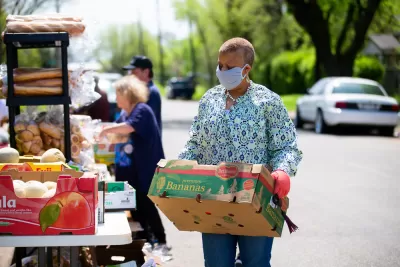A study from Des Moines found that households in historically redlined parts of town are more likely to have to seek help from food pantries.

An article by Linh Ta on Axios highlights the persistent negative impacts of redlining on American communities, citing a recent study from the Des Moines Area Religious Council that finds that households in that city’s historically redlined district are most likely to experience food insecurity.
“The redlined neighborhoods that lacked investment 90 years ago — many of which are on the city's south and east sides — are still suffering from economic instability and lower home ownership rates, according to DMARC.” Some of these areas are also at the highest risk for flooding, the report noted.
“Out of all the food pantry users in the Des Moines metro, about 43% of them live in a former C or D district, said Luke Elzinga, spokesperson for DMARC.” Homes classified as C or D properties were deemed “high risk” for lending. According to the report, “55% of multi-race Hispanic families that visited DMARC's food pantries lived in one of those districts compared to just 38% of white food pantry users.” Elzinga pointed to the need for support in multiple areas to reduce food insecurity among low-income households. “Factors like improving affordable housing options and childcare factor into economic stability.”
FULL STORY: Struggles continue in Des Moines' redlined district

Planetizen Federal Action Tracker
A weekly monitor of how Trump’s orders and actions are impacting planners and planning in America.

Congressman Proposes Bill to Rename DC Metro “Trump Train”
The Make Autorail Great Again Act would withhold federal funding to the system until the Washington Metropolitan Area Transit Authority (WMATA), rebrands as the Washington Metropolitan Authority for Greater Access (WMAGA).

DARTSpace Platform Streamlines Dallas TOD Application Process
The Dallas transit agency hopes a shorter permitting timeline will boost transit-oriented development around rail stations.

Renters Now Outnumber Homeowners in Over 200 US Suburbs
High housing costs in city centers and the new-found flexibility offered by remote work are pushing more renters to suburban areas.

The Tiny, Adorable $7,000 Car Turning Japan Onto EVs
The single seat Mibot charges from a regular plug as quickly as an iPad, and is about half the price of an average EV.

Supreme Court Ruling in Pipeline Case Guts Federal Environmental Law
The decision limits the scope of a federal law that mandates extensive environmental impact reviews of energy, infrastructure, and transportation projects.
Urban Design for Planners 1: Software Tools
This six-course series explores essential urban design concepts using open source software and equips planners with the tools they need to participate fully in the urban design process.
Planning for Universal Design
Learn the tools for implementing Universal Design in planning regulations.
Roanoke Valley-Alleghany Regional Commission
City of Mt Shasta
City of Camden Redevelopment Agency
City of Astoria
Transportation Research & Education Center (TREC) at Portland State University
US High Speed Rail Association
City of Camden Redevelopment Agency
Municipality of Princeton (NJ)





























